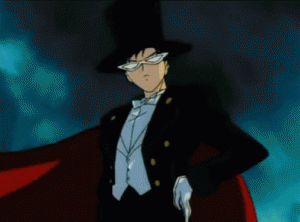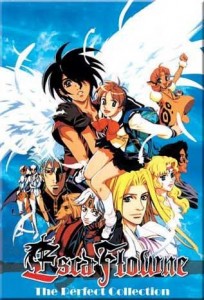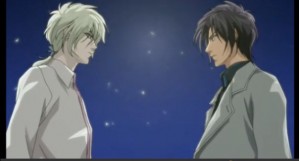I think one could easily write about Viz streaming the original Sailor Moon again with just four paragraphs of the word “SQUEE” and have that be a perfectly serviceable review, but having enjoyed watching the first few episodes of the series, I thought I would write about it a little bit. I’ve read some (but not all) of the Sailor Moon manga. I encountered the franchise first in the old Tokyopop editions, but I haven’t watched the anime that extensively before. I probably caught a few episodes of the dub when it was on TV before, and I’m quite fond of Tuxedo Mask animated gifs.
I haven’t watched the anime in order in subtitle format at all before, so I was quite happy that it was now available. The first four episodes firmly establish the character of Usagi/Sailor Moon, who starts out as a clumsy crybaby, and then becomes a clumsy crybaby with magical girl powers thanks to the intervention of the magical talking cat Luna. The clumsy girl who turns out to have extraordinary abilities is a very typical character type in both anime and manga, but Usagi manages to be a very appealing example of the type due to her inability to study for school, her devotion for naps, and her single-minded devotion to taking the easy path whenever possible. The first few episodes of the series follow the story elements of the manga fairly closely, as Usagi investigates the evil forces that seek to destroy the balance of the universe by capturing human energy through costume jewelry. Seriously the villains of Sailor Moon might have hit on something by appealing to the weak aspects of human nature, but they are surprisingly ineffective. Also, the balance of the universe often seems to be centered on struggles that take place very near Usagi’s neighborhood.
One thing that I enjoyed much more than I thought I would were the musical cues in the series. It is hilarious that whenever Mamoru/Tuxedo Mask makes an appearance, he brings with him the distant sound of castanets. I was also amused by the fact that Usagi’s crying sometimes acts like a sonic weapon. The first four episodes were fun to watch, but I find myself growing a bit impatient for the appearances of the other Sailor Guardians. Just as in the manga, there are references here and there to Sailor V, and I’m hoping that Mars and Mercury will show up very soon. I have a subscription to Hulu, so that’s where I’ve been watching Sailor Moon, but you can also watch it for free on Viz’s Neon Alley. I feel like Viz has kicked off the summer season by giving everyone a huge present, and I know I’m going to be looking forward to Mondays when new episodes are released!





Recent Comments